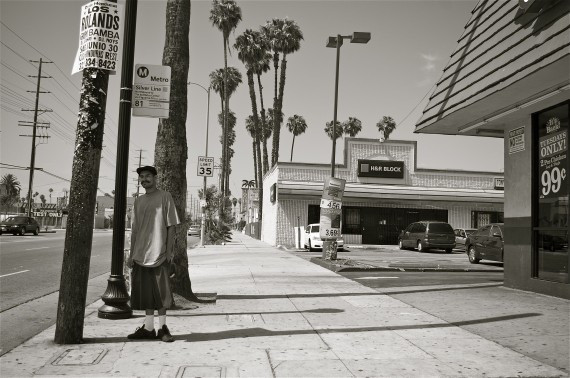
It's hard to take some of the hysteria surrounding the City Council's approval of Mobility Plan 2035 this past August very seriously.
And by "hysteria," I mean the lawsuit and most recent claims by Fix the City president James O'Sullivan, who told MyNewsLA that the city “want[s] to make driving our cars unbearable by stealing traffic lanes from us on major streets and giving those stolen lanes to bike riders and buses," and that, worse still, "...not all of us — in fact, very few of us — have the luxury of being able to ride to work on a bike or bus."
Oh, yes. All those transit-dependent people luxuriating on bikes and buses, stealing your lanes. How very selfish they are, indeed.
I'm sure that at this very moment, those very transit users are rubbing their hands together in collective selfish glee as they stand, sweating through their work and school clothes in 90-degree heat at a filthy sun-drenched bus stop while waiting for a bus that is late because it is stuck behind car traffic. In fact, they are probably high-fiving the sweaty cyclists riding past them on the sidewalk as we speak.
Some people are just so selfish.
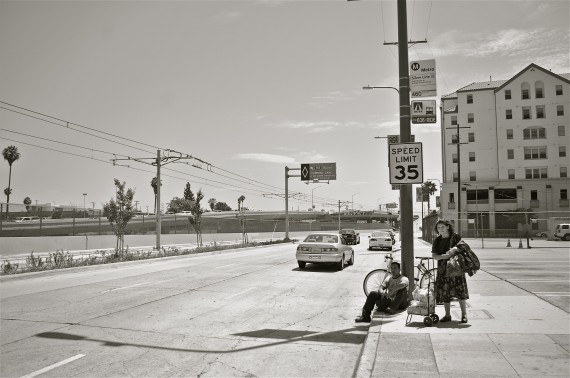
* * *
The crux of most arguments against the Mobility Plan generally lies in the notion that the needs of the many (beleaguered drivers) are being subjected to the whims of the few (mostly arrogant/entitled hipsters) -- a claim supported by census data suggesting that only 1% of folks in Los Angeles County ride bikes to work and just 11% use transit.
Which, I'll admit, can sound pretty damning.
At least on the surface. (And as long as you don't consider the possibility of people switching over to transit or cycling as more and better infrastructure for both goes in as part of the Mobility Plan [PDF]. But I digress.)
When you think about what those numbers mean on the ground, you have a completely different story on your hands. One that suggests that those doing the complaining are (inadvertently, I hope) advocating for the holding of lower-income Angelenos hostage to the very traffic conditions that they themselves find so abhorrent and destructive. Conditions that will continue to present challenges to lower-income residents who desperately want their neighborhoods and the children they raise there to grow and thrive and be healthy. And conditions that the complainants themselves had the means to escape.
Pshaw! Thou art a luxury-loving lane-stealer, you might be thinking to yourself.
Just bear with me.
And let's take the case of Central Avenue in South Los Angeles -- a street slated for a protected bike lane and road diet, per the Mobility Plan -- and see why a different approach to mobility matters.
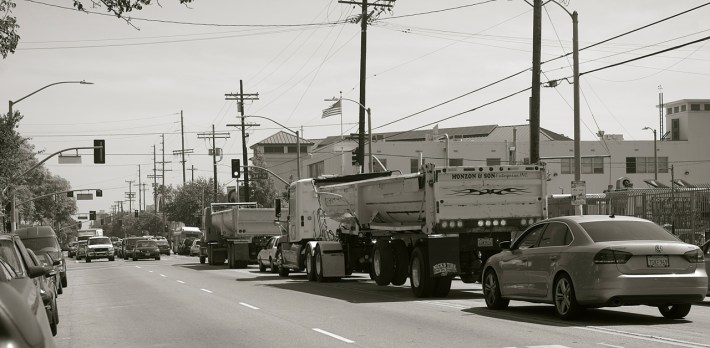
A very busy thoroughfare on the weekdays, Central connects the warehouses downtown to the 110 Freeway (via MLK Blvd.) and the 105 Freeway in Watts, and is popular with trucks looking to avoid the congested mess that is Alameda Street (which runs parallel to Central).
Which means that the streetscape environment is heavily dictated by (largely) non-resident cut-through congestion that picks up around 3 p.m. (above), just as kids are getting out of school.
Meanwhile, the low- and very low-income residents that live, work, and play in the densely populated neighborhoods flanking the corridor are heavily reliant on cycling, walking, and transit to get to work, to shop, or to get themselves or their kids back and forth to school.
The same census data that suggests just a fraction of county residents walk, bike, or ride transit also suggests that 71% of those using transit to get around have incomes under $25,000 (see Equity Atlas, p. 16). Lower-income commuters are also more likely to walk or bike to work, sometimes in combination with transit use. Given that the median income of the Historic South Central, Central-Alameda, and South Park communities hovers around the $30,000 mark (and family size at around 4 people), we can safely assume that to mean a significant proportion of the residents along Central spends an awful lot of time at the mercy of a streetscape environment dominated by people that have no stake in the community [Census figures support this, suggesting at least 18% of South L.A. residents are regular transit users.]
Spend any time along the street and you will see that that speculation bears out, and then some. Central bustles with pedestrians, transit riders, and cyclists at various times of the day. Parents walk and bike their children to elementary school in the morning or to after-school programs at youth centers like A Place Called Home. Bus route 53, connecting Cal State Dominguez to downtown via Central, is one of the busier in the city, seeing 14,502 weekly boardings. And the street actually hosts more cyclists than pedestrians during peak hours -- almost one cyclist per minute.
As you might guess, the oppressiveness of cut-through traffic is one of the top complaints made by those that must navigate the street on foot or by bike. The crush of massive trucks and impatient commuters keeps residents from feeling safe crossing the street, especially if they are with their families. And the overwhelming size of the trucks and the propensity of car drivers to dart in and around them puts pedestrians and cyclists at real risk for injury.
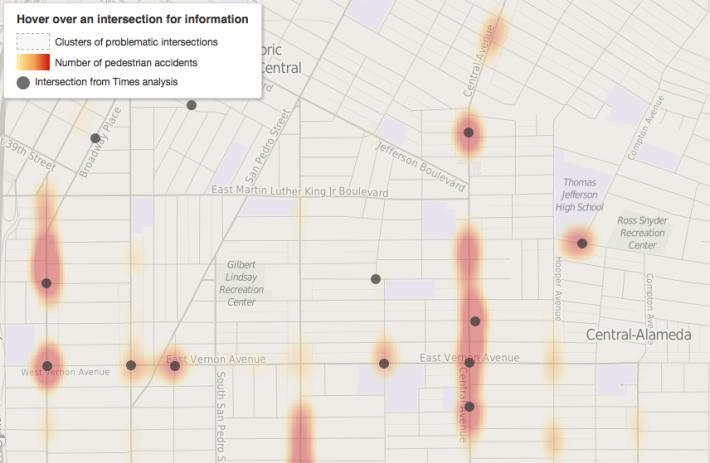
Conditions are so poor that bicyclists (including the occasional LAPD officer) generally take refuge on the sidewalks. Which leads to a second complaint, often heard from pedestrians and small business owners in the community: the fear that they are going to collide with a cyclist as they move in and out of the shops along the commercial corridor.
Being on the sidewalk can also put cyclists more at risk for being hit by cars moving to or from side streets, either because the driver is in a hurry to squeeze a turn in or because cyclists sometimes dart into intersections from sidewalks assuming they are visible or that they have been spotted by drivers (or some combination of all three).
Officially, the poor conditions along the street have resulted in nearly 300 people being hit while walking or biking along Central over a ten-year span, according to the Los Angeles County Bicycle Coalition. But both cyclists and pedestrians along the corridor tell me close calls with vehicles are a far more regular occurrence. Many cyclists even report having been hit several times, despite never having communicated any of those incidents to the authorities. Their testimony suggests the underreporting of collisions stems from the incidents being hit-and-runs in which they weren't badly injured, cases in which the driver stopped to render aid and/or offered to pay for any damages to the bike, or cases where it was clear to the victim that the driver was indigent and unable to pay for damages.
All of which implies that the street is even less safe for residents than we suppose.
And all of which is further complicated by the fact that those walking or biking need access to Central Ave., regardless of how unsafe it can be. For residents and cycling commuters, it is a lifeline. The presence of gangs in the neighborhoods surrounding the corridor means that the side streets are off limits to those just passing through. The bustle of Central lends it some neutrality and offers potential witnesses and safe havens to duck into, should an issue arise.
It is therefore of the essence that Central be made safer and more accessible to all users, cyclists included. Even if prioritizing the safety of the most vulnerable inhabitants of a community means curtailing the convenience with which non-residents can cut through it.
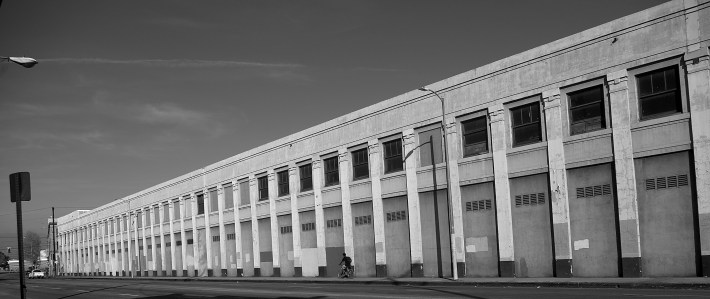
* * *
None of this is to suggest that, in opposing the objectives of the Mobility Plan, James O'Sullivan and Laura Lake of Fix the City or any of the other opponents (including wayward councilmembers Curren Price, Paul Koretz, and Gil Cedillo) are actively seeking to subject vulnerable lower-income Angelenos to more dangerous and unhealthy conditions. They are only thinking of themselves and their own quality of life (and the interests they might be beholden to, ahem).
And that's a big part of the problem.
The larger conversations around the Mobility Plan have not done enough to address the way in which our fair city's current configuration (combined with the reluctance to provide and/or safeguard affordable housing) impacts the health and well-being of the lower-income families that inhabit our urban cores. Or what a challenge mobility can be when rising rents strain already constrained budgets. Or how gentrification and displacement can harm the ability of transit-dependent people to keep jobs, be available to nurture their families, or be part of a cohesive community when it takes them even longer to reach their destinations via transit or bike. Nor have we really heard connections made between the reluctance of Angelenos to give up their cars and things like the harm caused by the decades' worth of lead, arsenic, and other emissions lead-acid (car) battery recycler Exide showered upon tens of thousands of lower-income East and Southeast L.A. residents.
The "luxury" O'Sullivan speaks of is not, as he believes, one of being able to choose to commute by bike or bus. It is in being able to speak of mobility in terms of convenience and choice. There are too many people -- too many of our fellow Angelenos -- that, by virtue of their lower-income status, have precious few options for how they move around the city and interact with their communities. They deserve access to the most basic of protections and pathways that will allow them to get from point A to point B safely. And they deserve slower, human-scale streets where they can linger with their families, support their local businesses, and build stronger communities without having to worry about dying every time they get on their bike to pedal to work or take their child's hand and step into the street.
If you think about it from that perspective, then it becomes clear the Mobility Plan isn't nearly ambitious enough. Not even close. Nor does it seem to be able to count on the political support it needs from the folks in charge of seeing it implemented. But it's a start. And that's better than nothing.
Let the lane-stealing begin!






